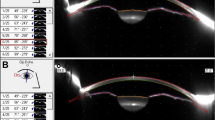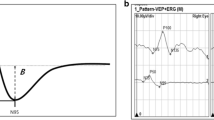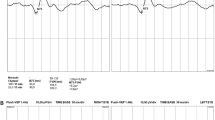Abstract
Purpose
To examine visual evoked potential (VEP) changes following botulinum toxin type A (BTA) administration in patients with blepharospasm.
Methods
Patients diagnosed with blepharospasm receiving BTA administration were included in the study. Three groups, a control group and two study groups (patients examined 14 days after BTA administration—Study Group 1, and patients examined 28 days after BTA administration—Study Group 2) were evaluated. Dilated fundus examinations were performed following detailed ophthalmological examinations and VEP tests. Keypoint (Dantec, Denmark) and ISCEV criteria were adopted for pattern VEP (PVEP) recording. BTA was applied in the form of local injections at a total 15–30 units, at 2.5–5 units per injection.
Results
A mean 19.4 ± 3.2 units of BTA was used for each eye. N70 (ms), P100 (ms), and P100 (uV) values were statistically significantly lower in both study groups following drug administrations compared to the control group (p < 0.001 for all). Significant positive correlation was observed between increased P100 amplitudes and age in the control group (p = 0.008, r = 0.200). Significant negative correlation was observed between the BTA units used and decreased P100 amplitudes in both study groups 1 and 2 following drug administrations (p = 0.017, r = − 0.180 and p = 0.043, r = − 0.153, respectively).
Conclusion
VEP may be an important method in the diagnosis and follow-up of blepharospasm and in determining the success of drug administration and additional therapeutic requirements.
Similar content being viewed by others
References
Barbosa ER, Silva HC, Haddad MS et al (1996) Blepharospasm: treatment with botulinum toxin. Rev Hosp Clin Fac Med Sao Paulo 51:220–223
Papapetropoulos S, Singer C (2007) Botulinum toxin in movement disorders. Semin Neurol 27:183–194
Lee JM, Baek JS, Choi HS et al (2018) Clinical features of benign essential blepharospasm in Korean patients. Korean J Ophthalmol 32:339–343
Cossu G, Mereu A, Deriu M et al (2006) Prevalence of primary blepharospasm in Sardinia, Italy: a service-based survey. Mov Disord 21:2005–2008
Nutt JG, Muenter MD, Aronson A et al (1988) Epidemiology of focal and generalized dystonia in Rochester, Minnesota. Mov Disord 3:188–194
Grandas F, Elston J, Quinn N et al (1988) Blepharospasm: a review of 264 patients. J Neurol Neurosurg Psychiatry 51:767–772
Fantato A, Parulekar M, Elston J (2019) A trial of a mechanical device for the treatment of blepharospasm. Eye (Lond) 33:1803–1808
Berardelli A, Curra A (2002) Pathophysiology and treatment of cranial dystonia. Mov Disord 17(Suppl 2):S70-74
Mukai Y, Kaji R (2011) Use of botulinum neurotoxin therapy. Brain Nerve 63:775–784
Frevert J (2010) Content of botulinum neurotoxin in Botox®/Vistabel®, Dysport®/Azzalure®, and Xeomin®/Bocouture®. Drugs R D 10:67–73
Jankovic J (1998) Medical therapy and botulinum toxin in dystonia. Adv Neurol 78:169–183
Hassell TJW, Charles D (2020) Treatment of blepharospasm and oromandibular dystonia with botulinum toxins. Toxins (Basel) 12:E269
Berardelli A, Conte A (2021) The use of botulinum toxin for treatment of the dystonias. Handb Exp Pharmacol 263:107–126
Tamcelik N (2011) Ocular electrophysiology, 2011th edn. Turkish Ophthalmological Association Education Publications, Istanbul
Jankovic J, Kenney C, Grafe S et al (2009) Relationship between various clinical outcome assessments in patients with blepharospasm. Mov Disord 24:407–413
Namiguchi K, Mizoue S, Ohta K et al (2018) Effect of botulinum Toxin A treatment on eyelid pressure in eyes with blepharospasm. Curr Eye Res 43:896–901
Brigell M, Bach M, Barber C et al (1998) Guidelines for calibration of stimulus and recording parameters used in clinical electrophysiology of vision. Calibration Standard Committee of the International Society for Clinical Electrophysiology of Vision (ISCEV). Doc Ophthalmol 95:1–14
Jinnah HA, Factor SA (2015) Diagnosis and treatment of dystonia. Neurol Clin 33:77–100
Patel B, Weinstein G (1998) Diagnosis and treatment of blepharspazm. Mosby Press, Louis St. In Nesi FA, Lisman RD, Levien MR
Powers JM (1982) Decongestant-induced blepharospasm and orofacial dystonia. JAMA 247:3244–3245
Jankovic J, Orman J (1984) Blepharospasm: demographic and clinical survey of 250 patients. Ann Ophthalmol 16:371–376
Colosimo C, Bologna M, Berardelli A (2015) How Do I Examine Blepharospasm? Mov Disord Clin Pract 2:449
Nicoletti AGB, Aoki L, Nahas TR et al (2010) Essential blepharospasm: literature review. Arq Bras Oftalmol 73:469–473
Odom JV, Bach M, Barber C et al (2004) Visual evoked potentials standard (2004). Doc Ophthalmol 108:115–123
Finsterer J, Stöllberger C, Shinar Y (2002) Cranial nerve lesions and abnormal visually evoked potentials associated with the M694V mutation in familial Mediterranean fever. Clin Rheumatol 21:317–321
Odom JV, Bach M, Brigell M et al (2016) ISCEV standard for clinical visual evoked potentials: (2016 update). Doc Ophthalmol 133:1–9
Kurysheva NI, Maslova EV, Trubilina AV et al (2018) Pattern visual evoked potentials and their relation to the peripapillary and retrobulbar blood flow in glaucoma. Vestn Oftalmol 134:19–27
Amini Vishteh R, Mirzajani A, Jafarzadehpur E et al (2020) Evaluation of visual evoked potential binocular summation after corneal refractive surgery. Doc Ophthalmol 140:181–188
Lavinsky J, Gus PI, Ehlers JA et al (2000) Visual-evoked potentials: assessment of retrobulbar and peribulbar anesthesia. J Cataract Refract Surg 26:1529–1532
Alimgil ML, Benian Ö, Esgin H (2001) Tiroid Orbitopatide Oküler Nabız Genliği. Görme Alanı ve Vep MNO 8:414–416
Clauser LC, Tieghi R, Galie’ M et al (2012) Surgical decompression in endocrine orbitopathy. Visual evoked potential evaluation and effect on the optic nerve. J Craniomaxillofac Surg 40:621–625
Egan RA, LaFrance WC (2015) Functional vision disorder. Semin Neurol 35:557–563
Suzuki Y, Kiyosawa M, Wakakura M et al (2019) Glucose hypometabolism in the visual cortex proportional to disease severity in patients with essential blepharospasm. Neuroimage Clin 24:101995
Funding
No funding was received for this research.
Author information
Authors and Affiliations
Contributions
"Dr. Eski wrote the main manuscript text and Dr. Teberik prepared tables 1-3. All authors reviewed the manuscript."
Corresponding author
Ethics declarations
Conflict of interest
All authors certify that they have no affiliations with or involvement in any organization or entity with any financial interest (such as honoraria; educational grants; participation in speakers' bureaus; membership, employment, consultancies, stock ownership, or other equity interest; and expert testimony or patent-licensing arrangements), or non-financial interest (such as personal or professional relationships, affiliations, knowledge or beliefs) in the subject matter or materials discussed in this manuscript.
Ethical approval
All procedures performed in studies involving human participants were conducted in accordance with the ethical standards of the institutional and/or national research committee (Duzce University Faculty of Medicine) and with the 1964 Declaration of Helsinki and its later amendments or comparable ethical standards.
Informed consent
Informed consent was obtained from all individuals participants included in the study.
Additional information
Publisher's Note
Springer Nature remains neutral with regard to jurisdictional claims in published maps and institutional affiliations.
Rights and permissions
Springer Nature or its licensor (e.g. a society or other partner) holds exclusive rights to this article under a publishing agreement with the author(s) or other rightsholder(s); author self-archiving of the accepted manuscript version of this article is solely governed by the terms of such publishing agreement and applicable law.
About this article
Cite this article
Eski, M.T., Teberik, K., Sezer, T. et al. Visual evoked potential changes following Botox administration in patients with blepharospasm. Int Ophthalmol 43, 2101–2107 (2023). https://doi.org/10.1007/s10792-023-02639-9
Received:
Accepted:
Published:
Issue Date:
DOI: https://doi.org/10.1007/s10792-023-02639-9




